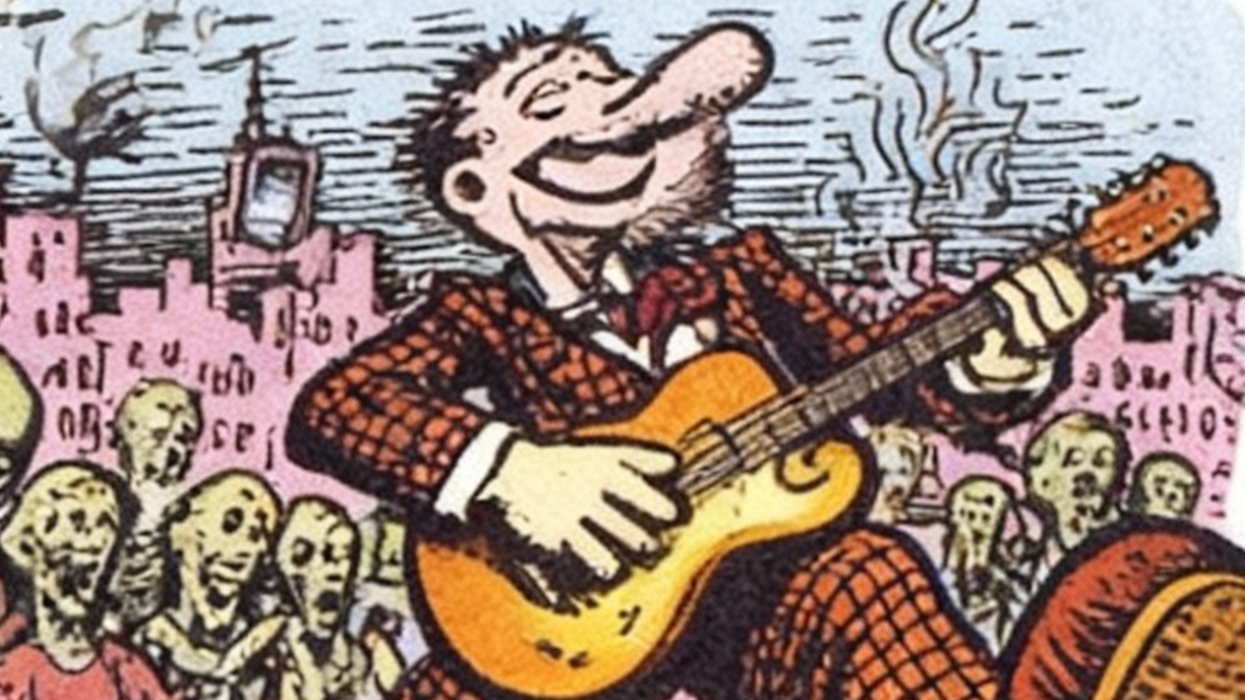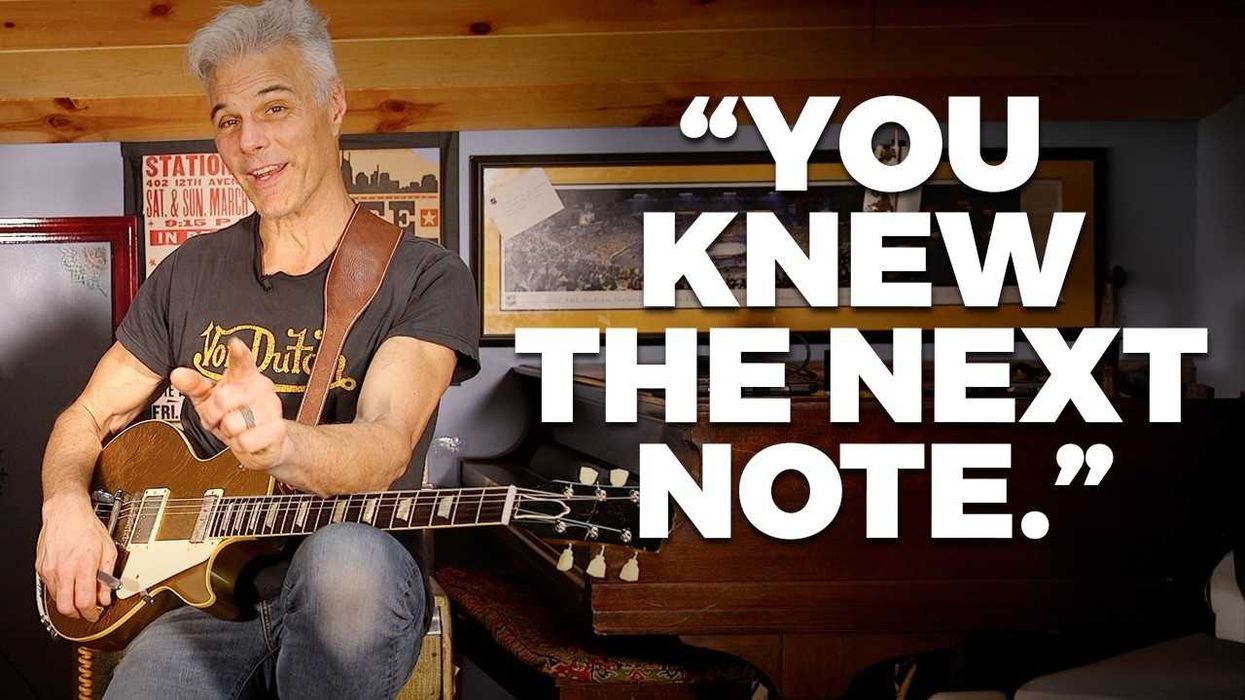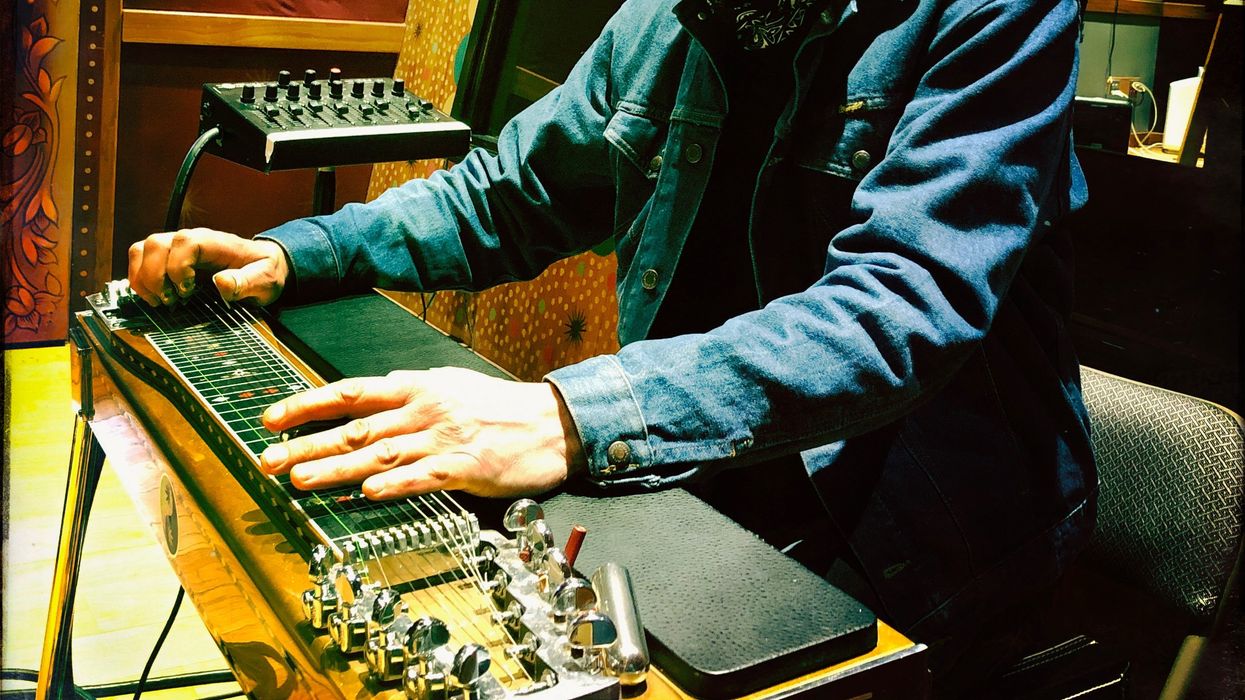For the most part, we guitarists make terrible bass players. We’re too busy, use more
notes than the song needs, we use too many
strings and too much of the neck. We tend
to live in front of the beat instead of right on
it or behind it. We use long, sustaining notes
instead of a dead thump that lays in tight
with the kick drum. In short, you can usually
tell when it’s a guitar player filling in on bass;
it never feels authentic. I love playing bass,
but I’m not too sure my band mates dig it
when I’m holding down the bottom end.
Although I play a lot of bass and have done
television and master scale sessions on bass,
I’m not a real bass player. I am an impostor
faking it. But I know what works and what
stinks it up, so I’m taking this opportunity
to tutor my six-string brethren on what to
embrace and avoid when you find yourselves
filling that regal position: holding down the
lowest of the lows. Pay attention, this information could save the groove.
The best albums ever recorded were played on a four-string bass. This may offend, but somebody needs to say it: if you’re playing a “bass” that has a neck as wide as an ironing board with six, seven, or (God forbid) even more strings on it, you need to hide that thing in your basement, unless you want to remain a soloist. A quick YouTube search provides lots of videos of guys doing some amazing things with these instruments, but they are always alone. You rarely see them working with a band. If you want to play music that a lot of people will actually listen to, get a good old Jazz or P-style. I can understand having a five string in the event you have to play in some odd female-singer keys, but if you’re playing with dudes, keep it to four and maybe consider removing the G string, lest it lead you into the temptation of working your way up to guitar range (I’m kind of kidding about the G string—but seriously, keep away from the high notes). Think: Jaco Pastorius, James Jamerson, Bootsy Collins, Paul McCartney, Flea, John Entwistle, Billy Sheehan, Stanley Clarke, Victor Wooten, Jack Bruce, Geddy Lee, Les Claypool, Donald “Duck” Dunn, John Paul Jones, and Brian Wilson. If experimental bass giants like these cats can do the majority of their work on four strings, should mere mortals like us question their practice?
While I’m offending, here’s something else to inspire hate mail: unless you’re playing Jazz Odyssey, resist the temptation to solo on bass. I’m talking solos, where the bass player starts doing the whole dweedle-la-dweedle-la-slap-a-slap-a-whack-a-whack. The groove disappears, the meter goes to hell and people leave the venue. Use that creative energy for composing perfect bass lines like “Come Together” or “Sweet Emotion.” Take your part to a place that lifts the entire song, supports the singer, drives the track. If you’re a jazzer, sure, blow. But if you’re playing commercial music with singers, save all that solo stuff for the higher register players, because somebody has to hold the song together, and a wimpy guitar or piano is not going to replace a bass foundation. Listen to a James Jamerson track: his lines at times sound like a three minute solo, moving all the time. Part of his genius was his ability to hold the groove together, supporting the singers and soloists while pumping out these incredibly creative, constantly moving parts. It’s the bass player’s job to hold the song together.
To be a good bassist, you kind of have to be the generous type... anything for the good of the band. This brings me to my favorite bassist, Paul McCartney, who strangely enough remains my favorite, even though he plays like a guitarist using lots of notes all the way up the neck and doesn’t follow the kick pattern.
Paul McCartney became one of the most influential bassists of all time because he was the only one in the band willing to take one for the team. Sir Paul said that after Stu left and The Beatles suddenly found themselves sans bass, “Everyone sort of turned ‘round and looked at me. I was a bit lumbered with it, really—it was like, ‘Well... it’d better be you, then.’ I don’t think you would have caught John doing it; he would have said: ‘No, you’re kidding. I’ve got a nice new Rickenbacker!’ I was playing piano and didn’t even have a guitar at the time, so I couldn’t really say that I wanted to be a guitarist” (Bass Player magazine, July/August 1995). Paul took the bass position because he was the generous one, who thought more about the songs and the band than about his personal glory. Although Paul is a capable soloist on piano and guitar, he avoided bass solos, trading the glory for the satisfaction of a solid groove—and he did it all on his beloved four- string Hofner and Rick. His bass is the foundation of all of that amazing music.
Enough preaching! Here’s a final tip for those who find themselves on the bottom end: try putting your foot right on the kick drum’s front head where you can feel the pattern. This will help you lock in tight with a drummer. Even if it’s your first gig with a drum- mer, the groove will feel like you’ve played together for years.
John Bohlinger
John Bohlinger is a Nashville guitar slinger who works primarily in television, and has recorded and toured with over 30 major label artists. His songs and playing can be heard in major motion pictures, major label releases and literally hundreds of television drops. Fore more info visit johnbohlinger.com.
The best albums ever recorded were played on a four-string bass. This may offend, but somebody needs to say it: if you’re playing a “bass” that has a neck as wide as an ironing board with six, seven, or (God forbid) even more strings on it, you need to hide that thing in your basement, unless you want to remain a soloist. A quick YouTube search provides lots of videos of guys doing some amazing things with these instruments, but they are always alone. You rarely see them working with a band. If you want to play music that a lot of people will actually listen to, get a good old Jazz or P-style. I can understand having a five string in the event you have to play in some odd female-singer keys, but if you’re playing with dudes, keep it to four and maybe consider removing the G string, lest it lead you into the temptation of working your way up to guitar range (I’m kind of kidding about the G string—but seriously, keep away from the high notes). Think: Jaco Pastorius, James Jamerson, Bootsy Collins, Paul McCartney, Flea, John Entwistle, Billy Sheehan, Stanley Clarke, Victor Wooten, Jack Bruce, Geddy Lee, Les Claypool, Donald “Duck” Dunn, John Paul Jones, and Brian Wilson. If experimental bass giants like these cats can do the majority of their work on four strings, should mere mortals like us question their practice?
While I’m offending, here’s something else to inspire hate mail: unless you’re playing Jazz Odyssey, resist the temptation to solo on bass. I’m talking solos, where the bass player starts doing the whole dweedle-la-dweedle-la-slap-a-slap-a-whack-a-whack. The groove disappears, the meter goes to hell and people leave the venue. Use that creative energy for composing perfect bass lines like “Come Together” or “Sweet Emotion.” Take your part to a place that lifts the entire song, supports the singer, drives the track. If you’re a jazzer, sure, blow. But if you’re playing commercial music with singers, save all that solo stuff for the higher register players, because somebody has to hold the song together, and a wimpy guitar or piano is not going to replace a bass foundation. Listen to a James Jamerson track: his lines at times sound like a three minute solo, moving all the time. Part of his genius was his ability to hold the groove together, supporting the singers and soloists while pumping out these incredibly creative, constantly moving parts. It’s the bass player’s job to hold the song together.
To be a good bassist, you kind of have to be the generous type... anything for the good of the band. This brings me to my favorite bassist, Paul McCartney, who strangely enough remains my favorite, even though he plays like a guitarist using lots of notes all the way up the neck and doesn’t follow the kick pattern.
Paul McCartney became one of the most influential bassists of all time because he was the only one in the band willing to take one for the team. Sir Paul said that after Stu left and The Beatles suddenly found themselves sans bass, “Everyone sort of turned ‘round and looked at me. I was a bit lumbered with it, really—it was like, ‘Well... it’d better be you, then.’ I don’t think you would have caught John doing it; he would have said: ‘No, you’re kidding. I’ve got a nice new Rickenbacker!’ I was playing piano and didn’t even have a guitar at the time, so I couldn’t really say that I wanted to be a guitarist” (Bass Player magazine, July/August 1995). Paul took the bass position because he was the generous one, who thought more about the songs and the band than about his personal glory. Although Paul is a capable soloist on piano and guitar, he avoided bass solos, trading the glory for the satisfaction of a solid groove—and he did it all on his beloved four- string Hofner and Rick. His bass is the foundation of all of that amazing music.
Enough preaching! Here’s a final tip for those who find themselves on the bottom end: try putting your foot right on the kick drum’s front head where you can feel the pattern. This will help you lock in tight with a drummer. Even if it’s your first gig with a drum- mer, the groove will feel like you’ve played together for years.
John Bohlinger
John Bohlinger is a Nashville guitar slinger who works primarily in television, and has recorded and toured with over 30 major label artists. His songs and playing can be heard in major motion pictures, major label releases and literally hundreds of television drops. Fore more info visit johnbohlinger.com.











![Rig Rundown: Russian Circles’ Mike Sullivan [2025]](https://www.premierguitar.com/media-library/youtube.jpg?id=62303631&width=1245&height=700&quality=70&coordinates=0%2C0%2C0%2C0)






